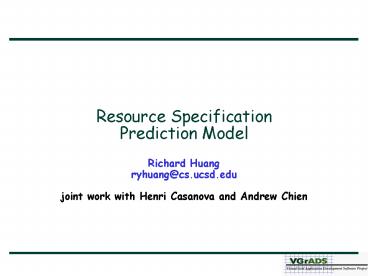Resource Specification Prediction Model - PowerPoint PPT Presentation
1 / 23
Title:
Resource Specification Prediction Model
Description:
Increasing availability of open source cluster management tools (e.g. ROCKS) ... For better tractability, at first consider only parallelism ( ) and regularity ... – PowerPoint PPT presentation
Number of Views:35
Avg rating:3.0/5.0
Title: Resource Specification Prediction Model
1
Resource Specification Prediction Model
- Richard Huangryhuang_at_cs.ucsd.edujoint work
with Henri Casanova and Andrew Chien
2
Introduction
- Advances in networking technology
- 10-40Gbps aggregate bandwidth
- Optical fibres
- More resources mean bigger problems can be solved
- Increasing deployment of clusters
- Decreasing hardware prices
- More choices in cluster vendors
- Increasing availability of open source cluster
management tools (e.g. ROCKS)
- Large-scale distributed environments (LSDEs) can
be used to run large-scale loosely synchronous
apps such as scientific workflows
3
Running Applications on LSDEs
- One key challenge in running scientific workflows
is resource selection
4
Whats the problem?
- Different resource selection systems are out
there (such as VGES) - How does one go about writing the resource
specification? - We dont know any other work that address this
problem.
5
Solution depends on
- Application (DAG) characteristics
- Type of scheduling algorithm employed
- Types of resources available
6
Assumptions
- Resources are plentiful
- Therefore we can pick the right size RC
- Resources are dedicated or have advanced
reservation OR - Underlying middleware (such as VGES) can take
care of interfacing with batch queue systems. - Bandwidth is reasonably plentiful
- We dont deal with network contention
- Performance models for applications so we know
task runtimes
7
Resource Specification Prediction Model
- Empirical Model uses input of DAG
characteristics and optional utility function - Heuristic Prediction Model predicts the best
scheduling heuristic to use - Size Prediction Model predicts the optimal
resource collection (RC) size
8
Strategy in Formulating Prediction Model
- Determine relevant DAG characteristics
- Define what the best RC should be
- Execute reference scheduling heuristic on an
observation set of DAG configurations while
varying relevant DAG characteristics - Derive model from the observation set results
that predicts the best RC size
9
Relevant DAG Characteristics
- DAG size
- Communication-to-computation ratio (CCR)
- Amount of parallelism
- Regularity among tasks from different DAG levels
- Other possible characteristics
- DAG height and average number of tasks per level
(subsumed by above characteristics)
10
Define best RC size
- Take an application and run it on different
number of hosts - Best RC size is where increasing the number of
hosts does not improve performance (knee value)
11
Observation Set
- Instantiate 10 random DAGs for each DAG
configuration - Vary number of tasks per level randomly while
maintaining parallelism, regularity, and size - Idea is to run scheduling heuristics on each DAG
configuration and try to see if we can detect
some trends
12
Size Prediction Model Formulation
- For better tractability, at first consider only
parallelism (?) and regularity (?) for each
(size, CCR) pair - Knee size seems to approximately double for every
0.1 increase in ? - Knee size decreases with increase in regularity
- Based on tables similar to one on right,
hypothesize size prediction could be modeled as
2(a?b?c)
Sample observation set knee values
13
Size Prediction Model Formulation
- We need to solve for a,b,and c for each (size
CCR) pair - Use linear regression to do planar fit of
logarithm of knee value - Interpolation between different DAG sizes and CCR
values
14
Model Validation
- Two workloads
- randomly generated DAGs (range of different DAG
characteristics) - Montage DAGs
- Performance Metric Application Turn-Around time
(scheduling time makespan) - Cost Derived cost from Amazons Elastic Cloud of
0.10 per hour for a 1.7 GHz processor - Use brute force method to calculate optimal size
15
Randomly generated DAGs
- Peak performance degradation was 15, but on
average, most were below 1 - Prediction model predicted smaller RC sizes
(reduces costs)
16
Comparison with using DAG width
- Using DAG width to try to maximize parallelism
costs a lot more! - Similar performance degradation as our model for
smaller DAGs - As DAG size increases, performce degrades rapidly
as scheduling times becomes larger because of
larger RC sizes
17
Performance Cost Tradeoff
- User can specify optional utility function
- For example 1 performance degradation for every
10 in cost - Knee threshold of 2 provides best utility in
this example
18
Montage
- Different thresholds did not degrade performance
too much - Better savings at higher thresholds (using fewer
hosts)
19
Sensitivity Analysis
- Previous results all based on homogeneous clock
rates and reference scheduling heuristic - Should look at how model reacts to
- Different levels of clock rate heterogeneity
- Different scheduling heuristics
20
Impact of Clock Rate Heterogeneity
21
Impact of Scheduling Heuristics
22
Summary
- We devised empirical model to predict good RC
size - We have shown that our model leads to good
application performance at often reduced costs
from optimal RC size - Our model maintains good performance over range
of DAG configurations, range of resource
heterogeneity, and over different scheduling
heurisitics
23
Future Work
- Heuristic Prediction Model to predict which
heuristic to use given input DAG and optional
utility function - How do we degrade gracefully when the resource
selection system cannot return the desired
resource collection - Translate output of our model into input to
different resource selection systems































